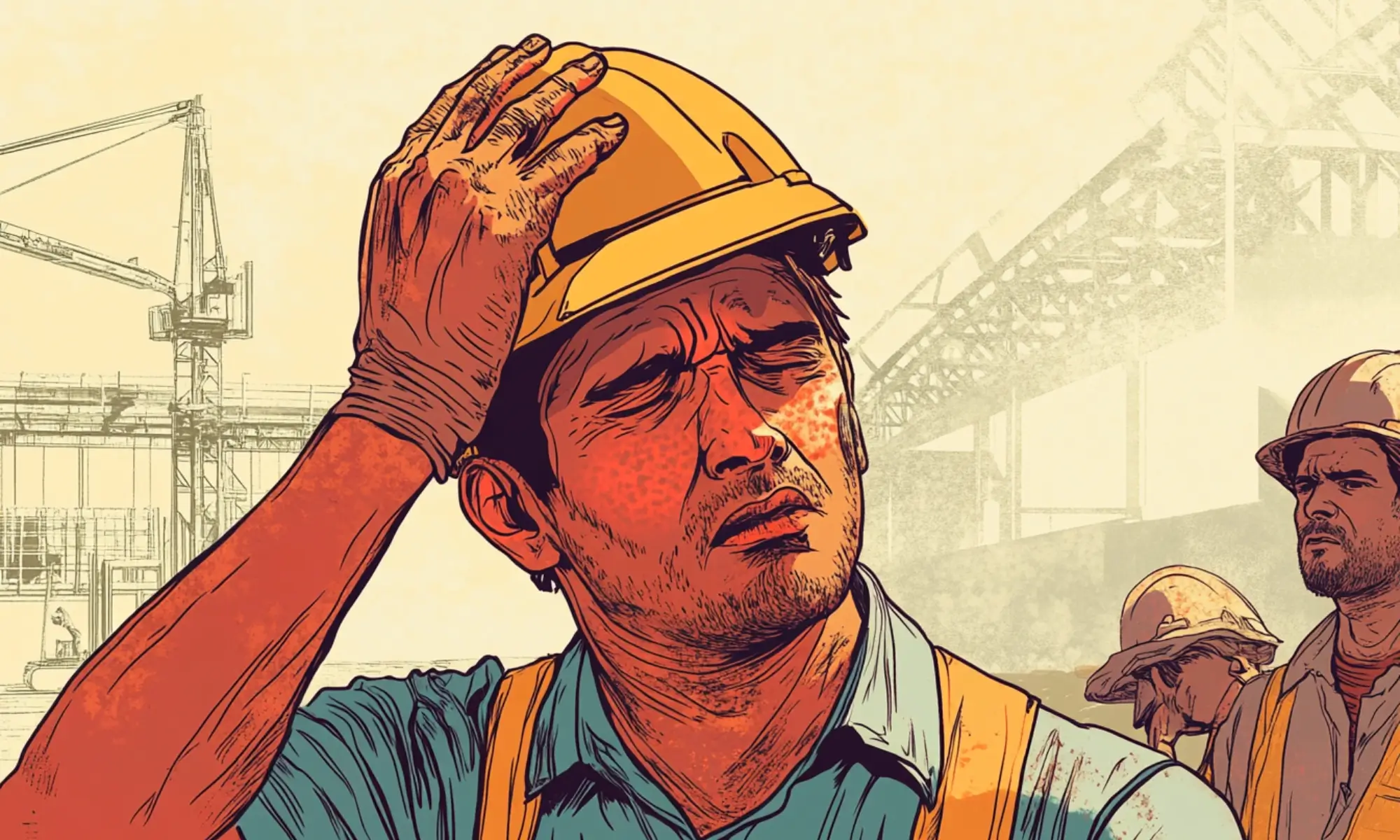Heat stress is a serious occupational and environmental health concern that arises when the body’s ability to regulate its internal temperature is overwhelmed by high temperatures, humidity, and physical exertion. This condition can lead to a range of heat-related illnesses, from mild heat rash to life-threatening heat stroke. Understanding heat stress, recognizing its symptoms, employing effective monitoring strategies, and implementing preventive measures are crucial for protecting workers and individuals in hot environments.
This comprehensive guide will provide insights into the definition of heat stress, its symptoms, how it can be monitored, and essential strategies for prevention.

What is Heat Stress?
Heat stress occurs when the body cannot adequately cool itself and maintain a stable internal temperature. This can lead to heat-related illnesses, which range from mild to life-threatening conditions. The risk is particularly high for workers in environments with high temperatures and humidity, such as construction sites, factories, kitchens, mines, and outdoor workspaces.
The body’s primary mechanism for cooling is sweating, which helps dissipate heat through evaporation. However, when environmental conditions—such as high humidity or extreme heat—hinder this natural process, the risk of heat stress increases significantly.

Symptoms of Heat Stress
Heat stress is a condition that arises when the body becomes unable to regulate its internal temperature due to prolonged exposure to high heat and humidity. Recognizing the different types of heat-related illnesses and their symptoms is critical for preventing severe health issues. Below is an explanation of the most common heat-related conditions and their symptoms, along with the recommended immediate actions:
1. Heat Stroke
The most severe form of heat stress, heat stroke is a life-threatening emergency that occurs when the body’s temperature regulation system fails and core body temperature rises to dangerous levels (above 106°F or 41°C).
Symptoms:
- High body temperature (above 106°F or 41°C)
- Confusion or altered mental state
- Seizures
- Hot, dry skin (due to the absence of sweating)
- Loss of consciousness
Immediate Action:
- Call emergency services immediately.
- Move the affected person to a shaded or cool area.
- Remove outer clothing to help cool the body.
- Use water, ice packs, or fans to lower body temperature.
- Wet the body with cool water and apply ice packs to armpits, neck, and groin.
- Offer fluids if the person is conscious, but only in small amounts.
2. Heat Exhaustion
A moderate heat-related illness caused by excessive loss of water and salt through sweating. It occurs when the body can no longer cool itself effectively.
Symptoms:
- Heavy sweating
- Weakness or fatigue
- Dizziness or lightheadedness
- Nausea or vomiting
- Cool, moist skin
- Fast, weak pulse
Immediate Action:
- Move the person to a cool, shaded area.
- Have them rest and drink plenty of fluids, preferably water or a sports drink.
- Cool the person with cold compresses or ice packs placed on the head, neck, and underarms.
- If symptoms do not improve within an hour or worsen, seek medical attention.
- Avoid allowing the person to return to strenuous activities for the rest of the day.
3. Heat Cramps
These are painful muscle spasms that occur due to heavy sweating and loss of electrolytes during physical activity in high heat.
Symptoms:
- Painful muscle cramps, often in the abdomen, arms, or legs
Immediate Action:
- Stop physical activity and rest in a cool place.
- Drink fluids with electrolytes, such as sports drinks, to replenish lost nutrients.
- Wait for a few hours before resuming strenuous activity.
- Seek medical attention if cramps persist or worsen.
4. Heat Rash
A mild heat-related condition that develops when sweat ducts become blocked and perspiration gets trapped under the skin, causing a red, itchy rash.
Symptoms:
- Red, itchy bumps on the skin, often in areas where clothing traps sweat (e.g., neck, upper chest, and skin folds)
Immediate Action:
- Move to a cooler, less humid environment when possible.
- Keep the affected area dry and avoid further sweating.
- Wear loose, breathable clothing to help reduce irritation.
- Keep the skin cool using water or a damp cloth.
Recognizing the symptoms of heat-related illnesses and taking prompt action is crucial to prevent serious complications or fatalities. Simple steps like staying hydrated, taking breaks in shaded or air-conditioned areas, and using appropriate clothing can make a significant difference in protecting against heat stress. Both individuals and workplaces need to have awareness and strategies in place for preventing and managing heat stress effectively.

Monitoring Heat Stress
Effectively monitoring and assessing heat stress in workplaces and outdoor environments is crucial for preventing heat-related illnesses and ensuring the safety and well-being of workers. Here are some commonly used strategies and tools for comprehensive heat stress monitoring:
1. Wet-Bulb Globe Temperature (WBGT)
The WBGT is an essential index that incorporates multiple environmental factors to provide a comprehensive measure of heat stress. It considers:
- Air temperature
- Humidity levels
- Wind speed
- Solar radiation
Usage: The WBGT is widely adopted in occupational health to determine safe work-rest cycles and establish heat exposure guidelines. It helps assess the environmental conditions and inform necessary precautions, such as altering work shifts, scheduling rest breaks, and ensuring hydration.
2. Universal Thermal Climate Index (UTCI)
The UTCI is another valuable tool for evaluating heat stress. It calculates a “feels-like” temperature that takes into account:
- Air temperature
- Radiant temperature (including solar and longwave radiation)
- Wind speed
- Humidity
Application: The UTCI is beneficial for understanding thermal comfort and predicting the human physiological response to varying levels of heat stress. This index is particularly useful for urban planning, outdoor work management, and sports activities where a detailed assessment of environmental heat impact is necessary.
3. Personal Monitoring
Personal monitoring focuses on assessing the physical responses of individuals exposed to heat, providing early warning signs of heat strain and allowing for timely intervention. Key metrics include:
- Heart Rate: Elevated heart rates can indicate that the body is under stress while attempting to cool down.
- Core Body Temperature: A rise in body temperature signals that the body’s cooling mechanisms might be failing.
- Hydration Levels: Monitoring fluid intake and signs of dehydration helps in preventing heat-related illnesses.
Method: Wearable technology and personal sensors can be used to track these indicators continuously. Workers should be encouraged to self-monitor for signs of heat exhaustion, such as increased pulse rates and excessive sweating, and supervisors should keep an eye on workers, particularly those in high-risk conditions or wearing protective gear.
Monitoring heat stress is a proactive measure to prevent heat-related illnesses and enhance workplace safety. By employing tools like WBGT and UTCI, along with personal monitoring practices, employers can create safer work environments. These strategies not only mitigate risk but also help maintain productivity and health during extreme heat conditions. Proper education, regular monitoring, and swift response to early signs of heat strain are essential for effective heat stress management.

Prevention of Heat Stress
Preventing heat stress requires a multifaceted approach that includes engineering controls, administrative practices, and personal protective measures. Below are some key strategies:
1. Engineering Controls
- Improve Ventilation: Install fans and ventilation systems to enhance air circulation.
- Air Conditioning: Use air conditioning where feasible, especially in high-risk indoor environments like factories and kitchens.
- Insulation and Barriers: Insulate hot surfaces and use reflective shields to reduce radiant heat exposure.
2. Administrative Controls
- Scheduling Work: Plan physically demanding tasks for cooler parts of the day, such as early morning or late evening.
- Work-Rest Cycles: Implement a schedule that allows workers to take regular breaks in shaded or air-conditioned areas.
- Hydration Policies: Ensure easy access to drinking water and encourage workers to drink regularly, even if they are not thirsty.
- Training and Awareness: Educate workers on the risks of heat stress, early symptoms, and what to do in case of an emergency. Comprehensive training programs can empower employees to recognize and respond to heat-related risks.
3. Personal Protective Equipment (PPE)
- Cooling Vests and Clothing: Use specially designed cooling garments or reflective clothing to help regulate body temperature.
- Breathable Fabrics: Wear lightweight, loose-fitting, and light-colored clothing to facilitate sweat evaporation and air circulation.
- Specialized Gear: In extremely hot conditions, workers can use thermally conditioned clothing or gear with built-in cooling systems, such as those with air-cooling packs or dry ice compartments.
Key Takeaways
Heat stress is a significant and preventable risk that affects workers in a variety of industries. Understanding its causes, recognizing the symptoms early, and implementing a combination of engineering, administrative, and personal protection strategies are essential for minimizing the risk of heat-related illnesses.
By adopting these preventive measures and creating a safety-focused workplace culture, employers can ensure the health and productivity of their workforce, even in challenging environments.
Stay Cool, Stay Safe: Equip your team with the tools and knowledge to recognize, prevent, and respond to heat stress effectively. Being proactive can mean the difference between a safe workday and a potentially life-threatening emergency.

